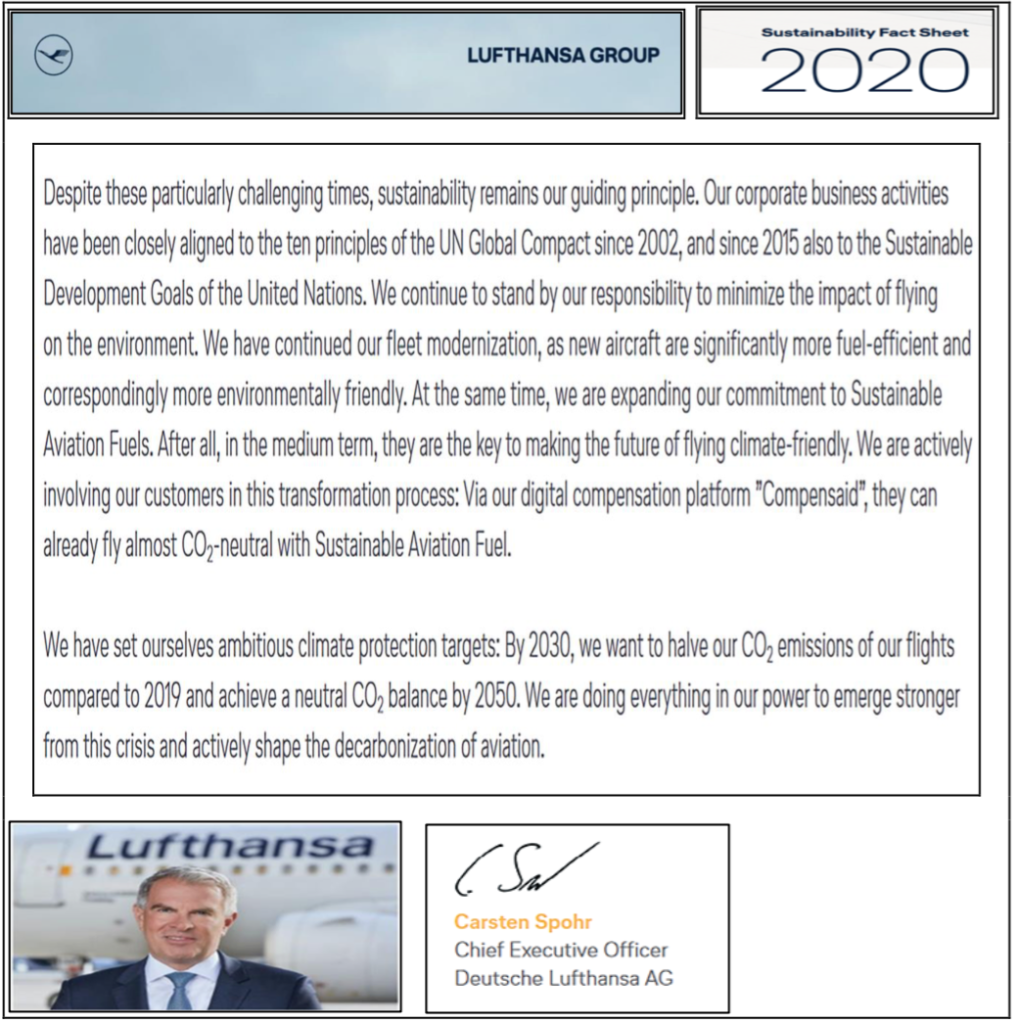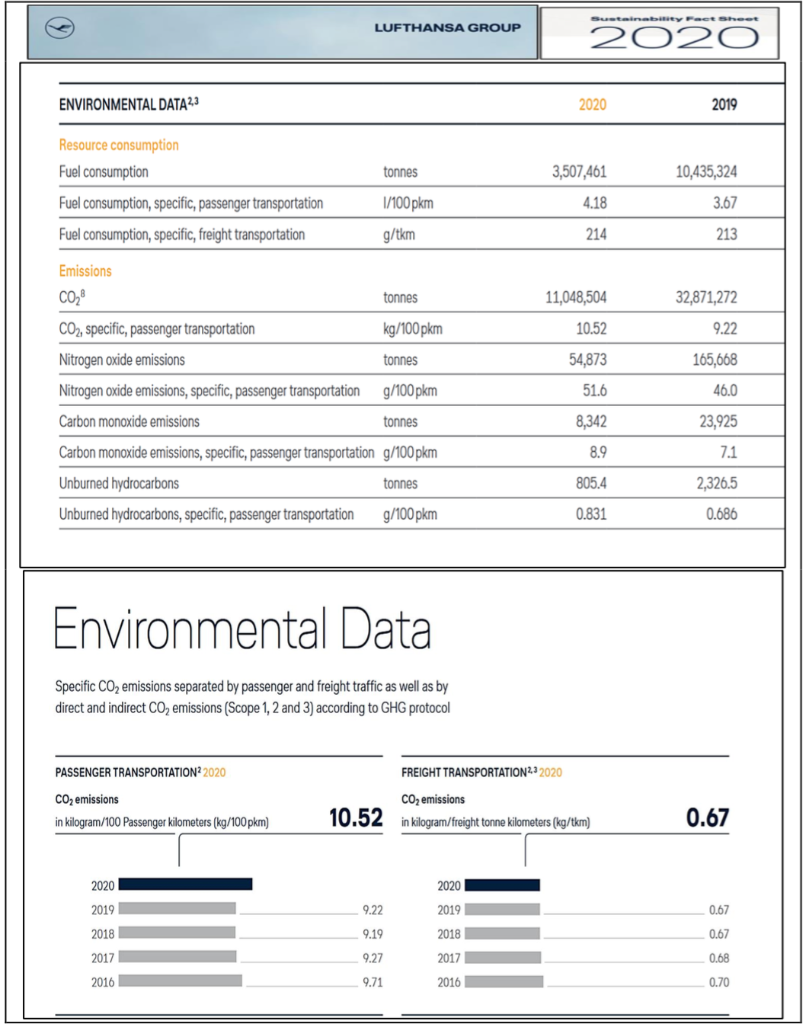QUESTION 2: International Corporate Social Responsibility Reporting (ICSRR)
In our class discussions on International Corporate Social Responsibility Reporting (ICSRR), we focused on the key issue of whether ICSRR should be mandated at the international level. In addition, we discussed a range of current ICSRR-related issues that have been reported globally such as the high levels of pollution and soil and water contamination being experienced in many countries. The following questions relate to these discussions and the extracts below from the 2020 Sustainability Fact Sheet of the Lufthansa Group Ltd (LGL), a German company operating in the airline industry. Relevant references to the mandatory readings for ICSRR must be provided to support your answers.

REQUIRED:
-
(a) Identify any key strengths and weaknesses of the LGL Environmental Data provided as set out in the extracts provided and discuss whether the LGL Sustainability Fact Sheet is of any value to global investors based on these strengths and weaknesses. In your answer discuss whether you think the quality and existence of these Environmental Data disclosures by the LGL are as predicted under Grays Accounting Values Model.
[10 Marks]
-
(b) Using the LGL extracts provided, identify whether the 2020 Sustainability Fact Sheet of the LGL meets the definition of a triple bottom line report. In your answer identify the key requirements of triple bottom line reporting (TBLR) and discuss which theory or theories you believe formed the basis of the decision by the LGL to adopt a sustainable corporate governance approach. Use one quote from the LGL extracts to support your answer.
[8 Marks]
Sustainability Fact Sheet LUFTHANSA GROUP 2020 Despite these particularly challenging times , sustainability remains our guiding principle. Our corporate business activities have been closely aligned to the ten principles of the UN Global Compact since 2002, and since 2015 also to the Sustainable Development Goals of the United Nations. We continue to stand by our responsibility to minimize the impact of flying on the environment. We have continued our fleet modernization, as new aircraft are significantly more fuel-efficient and correspondingly more environmentally friendly . At the same time, we are expanding our commitment to Sustainable | Aviation Fuels. After all, in the medium term, they are the key to making the future of flying climate-friendly . We are actively involving our customers in this transformation process: Via our digital compensation platform "Compensaid" , they can | already fly almost CO2-neutral with Sustainable Aviation Fuel. We have set ourselves ambitious climate protection targets : By 2030, we want to halve our CO2 emissions of our flights compared to 2019 and achieve a neutral CO, balance by 2050. We are doing everything in our power to emerge stronger from this crisis and actively shape the decarbonization of aviation. Lufthansa CS Carsten Spohr Chief Executive Officer Deutsche Lufthansa AG Suty Face Sot LUFTHANSA GROUP 2020 ENVIRONMENTAL DATA 23 2020 2019 Resource consumption Fuel consumption tonnes 3,507,461 10,435,324 Fuel consumption, specific, passenger transportation 1/100 pkm 4.18 3.67 Fuel consumption, specific, freight transportation g/km 214 213 Emissions CO2 tonnes 11,048,504 32,871,272 kg/100 pkm 10.52 9.22 CO2, specific, passenger transportation Nitrogen oxide emissions Nitrogen oxide emissions, specific, passenger transportation tonnes 54,873 165,668 g/100 pm 51.6 46.0 Carbon monoxide emissions tonnes 8,342 23,925 8.9 7.1 Carbon monoxide emissions, specific, passenger transportation g/100 pkm Unburned hydrocarbons tonnes Unburned hydrocarbons, specific, passenger transportation g/100 pkm 805.4 2,326.5 0.831 0.686 Environmental Data Specific CO2 emissions separated by passenger and freight traffic as well as by direct and indirect CO2 emissions (Scope 1, 2 and 3) according to GHG protocol PASSENGER TRANSPORTATION? 2020 CO2 emissions in kilogram/100 Passenger kilometers (kg/100 pkm) FREIGHT TRANSPORTATION23 2020 CO2 emissions 10.52 in kilogram/ freight tonne kilometers (kg/tkm) 0.67 2020 2020 2019 9.22 2019 0.67 2018 9.19 2018 0.67 2017 9.27 2017 0.68 2016 9.71 2016 0.70 Sustainability Fact Sheet LUFTHANSA GROUP 2020 Despite these particularly challenging times , sustainability remains our guiding principle. Our corporate business activities have been closely aligned to the ten principles of the UN Global Compact since 2002, and since 2015 also to the Sustainable Development Goals of the United Nations. We continue to stand by our responsibility to minimize the impact of flying on the environment. We have continued our fleet modernization, as new aircraft are significantly more fuel-efficient and correspondingly more environmentally friendly . At the same time, we are expanding our commitment to Sustainable | Aviation Fuels. After all, in the medium term, they are the key to making the future of flying climate-friendly . We are actively involving our customers in this transformation process: Via our digital compensation platform "Compensaid" , they can | already fly almost CO2-neutral with Sustainable Aviation Fuel. We have set ourselves ambitious climate protection targets : By 2030, we want to halve our CO2 emissions of our flights compared to 2019 and achieve a neutral CO, balance by 2050. We are doing everything in our power to emerge stronger from this crisis and actively shape the decarbonization of aviation. Lufthansa CS Carsten Spohr Chief Executive Officer Deutsche Lufthansa AG Suty Face Sot LUFTHANSA GROUP 2020 ENVIRONMENTAL DATA 23 2020 2019 Resource consumption Fuel consumption tonnes 3,507,461 10,435,324 Fuel consumption, specific, passenger transportation 1/100 pkm 4.18 3.67 Fuel consumption, specific, freight transportation g/km 214 213 Emissions CO2 tonnes 11,048,504 32,871,272 kg/100 pkm 10.52 9.22 CO2, specific, passenger transportation Nitrogen oxide emissions Nitrogen oxide emissions, specific, passenger transportation tonnes 54,873 165,668 g/100 pm 51.6 46.0 Carbon monoxide emissions tonnes 8,342 23,925 8.9 7.1 Carbon monoxide emissions, specific, passenger transportation g/100 pkm Unburned hydrocarbons tonnes Unburned hydrocarbons, specific, passenger transportation g/100 pkm 805.4 2,326.5 0.831 0.686 Environmental Data Specific CO2 emissions separated by passenger and freight traffic as well as by direct and indirect CO2 emissions (Scope 1, 2 and 3) according to GHG protocol PASSENGER TRANSPORTATION? 2020 CO2 emissions in kilogram/100 Passenger kilometers (kg/100 pkm) FREIGHT TRANSPORTATION23 2020 CO2 emissions 10.52 in kilogram/ freight tonne kilometers (kg/tkm) 0.67 2020 2020 2019 9.22 2019 0.67 2018 9.19 2018 0.67 2017 9.27 2017 0.68 2016 9.71 2016 0.70








